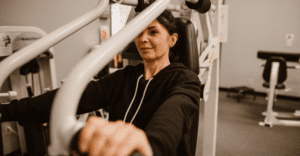About the Three Stages of Menopause: Peri, Meno and Post


Menopause is a natural process, which normally takes a number of years. We take a look at the three stages of menopause – perimenopause, menopause and postmenopause – and how they can affect you, together with some tips for coping.
Menopause is the point at which a woman’s ovaries stop producing eggs, and her periods come to an end. Menopause normally happens between the ages of 44 and 55, with the average age being 51.
However, the transition to menopause is a gradual process, and some significant changes begin to happen in the months and years leading up to menopause, as hormone levels start to decline. Women can experience a range of different symptoms at each stage.
Perimenopause
Perimenopause refers to the period of time before menopause, when a woman’s hormone levels start to change as her ovaries gradually begin to produce less oestrogen and progesterone.
During perimenopause, you may begin to experience a range of menopausal symptoms, which commonly include:
Irregular periods
This is often one of the first signs that you are in the perimenopause stage. The menstrual cycle starts to become erratic, and bleeding can be heavier and last longer. Missed periods, shorter periods and spotting between periods are also common. Some women also experience an increase in Premenstrual Syndrome symptoms, such as cramping and breast tenderness.
Hot flushes and night sweats
These affect up to 75% of perimenopausal women, and often continue through to the postmenopause stage. Also known as hot flashes, they are a sudden rush of heat, often followed by excessive sweating, palpitations, chills and reddening of the skin.
Vaginal dryness and low sex drive (libido)
Changing hormones can cause a drop in sexual desire as well as changes to the vaginal area. The vagina can become drier and less lubricated, which can cause itching and irritation, and may make sex uncomfortable or painful.
Sleep disturbances
You may have problems with getting to sleep, waking frequently during the night, or waking in the early hours.
Mood swings
It’s common to experience sudden changes in mood, irritability, depression or anxiety.
Other common menopausal symptoms can include: headaches, fatigue, feeling the need to urinate more often, joint and muscle pain, brain fog and difficulty concentrating.
Menopause
Menopause is the point at which the ovaries finally stop releasing eggs, and menstruation stops. A woman has officially reached menopause when she hasn’t had a period for 12 months in a row.
By this point oestrogen levels have dropped substantially, and many of the symptoms you experienced during perimenopause are likely to subside, although others may continue, including:
- Hot flushes
- Vaginal dryness
- Insomnia
- Urinary urgency
- Brain fog and difficulty concentrating
Postmenopause
Postmenopause describes the period in a woman’s life after menopause has been reached.
Many women will now see a general reduction in their menopause symptoms overall, although you may continue to experience some symptoms following menopause, including:
- Hot flushes – these normally subside after 1-2 years
- Vaginal dryness and thinning of the vaginal tissues (atrophy)
- Loss of bladder control
- Mood changes or depression
- Brain fog and forgetfulness
After menopause, women are also more at risk of problems such as osteoporosis (a thinning of the bones) and heart disease, so it’s important to make healthy lifestyle choices.
Eating a balanced diet, which includes plenty of iron, calcium and vitamin D, doing regular exercise, avoiding smoking, and limiting your caffeine and alcohol intake can all help to reduce the risks.
Coping with the three stages of menopause
Menopause is a natural phase of life, and each stage can have its challenges. The good news is, the majority of symptoms begin to ease off as you progress through the menopause – and there are lots of things you can do in the meantime to help feel more comfortable.
Here are some top tips for dealing with some of the most common symptoms that occur at the different stages of menopause:
- Hot flushes and night sweats – you can help to turn down the heat by dressing in layers and wearing loose, light clothing made from natural materials such as bamboo, which is naturally moisture-wicking. Avoid hot, spicy foods, alcohol and caffeine and drink plenty of cool fluids.
- Vaginal dryness and low libido – using topical creams, moisturisers and lubricants can help to relieve vaginal soreness and restore suppleness. Meanwhile, a stimulating gel can help to improve sensation. Remaining sexually active can also help to retain vaginal elasticity. You can view a range of intimate aids here.
- Urinary issues – doing Kegel exercises can help to strengthen the muscles in the pelvis (the pelvic floor).
- Insomnia – make sure your bedroom is comfortable and well ventilated by opening the windows or using a fan. Many women find that wearing a sleep mask and using a relaxing sleep balm can also help them get a better night’s sleep.
- Mood swings and anxiety – practising relaxation techniques, such as deep breathing, yoga and mindfulness can help with mental wellbeing. Doing some regular exercise can also help to balance your hormones, reduce hot flushes and boost your mood, as well as helping you to maintain a healthy weight.
It would be best to consider Post and Perimenopause Tests.
About Live Better With
This article was originally written and published by our partner Live Better With.
Live Better With’s mission is to make everyday living a bit better for the millions of people living with long term health conditions, all over the world. We do this through thousands of curated products, informative content, useful services and a thriving online community. Visit Live Better With here.













































